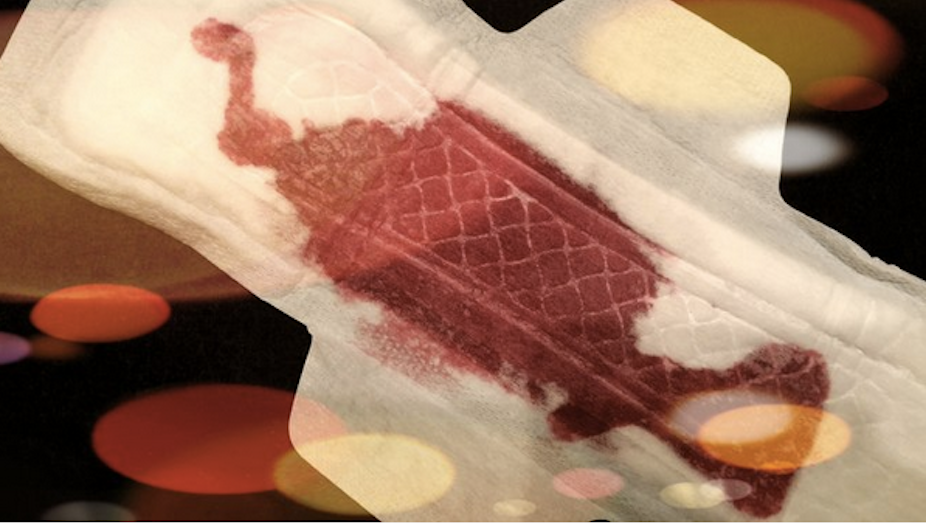Imagine if men were as disgusted with rape as they are with periods.
Reads one of the sanitary pads Elone Kastrati stuck up all over the streets of Karlsruhe Germany. This is probably not the imagined use when Southball designed the first commercial disposable sanitary pads in 1888. Read the Explainer on why women menstruate.
Last week, the #PadsAgainstSexism campaign went viral on Instagram and Tumbler using the “menstrual taboo” to call attention to sexism and the rape of women.
The spread of the campaign to university students in New Delhi and Kolkota, India has expanded the focus of the campaign to include more directly the stigma attached to menstruation.
One of the New Delhi co-coordinators, Deepti Sharma says:
The stigma around menstrual blood reveals the love-hate relations that our society has with women’s bodies and their sexuality —where it must control it with words like ‘goddess’ and ‘dutiful wife’ or revile it. This vision does not work for us anymore and we refuse to accept it.
In last year’s protest performances by the Spanish group Sangre Menstrual, the women created a more powerful visual statement by wearing white pants stained with menstrual blood out in the streets.
These forms of period power protests seek to critique the devaluing of women and female-gendered bodies in society. Yet, their shock value, which makes them go viral, still relies upon the taboo of menstrual blood.
By taboo, I mean the prohibitions against menstruating women’s participation in certain activities, especially regarding food and sex, as well as social silences surrounding their condition.
Menstrual power protests that use the menstrual taboo are fascinating. But, I wonder if there are there other forms of menstrual power protests that people can perform to improve the social status of women.
Anthropology has been fascinated with menstruation since the earliest days of the field. The 1874 first edition of Notes and Queries on Anthropology listed menstruation as one of the categories of potential taboos that “travellers and residents of uncivilised lands” should note.
British anthropologist Mary Douglas only brief mentions menstruation in her 1966 famous book Purity and Danger, but her ideas about taboo and pollution in regards to the presence of bodily fluids on the boundaries of being inside and outside the body inform our contemporary explanations for the disgust and shame attached to seeing, smelling, or touching menstrual blood.
In the 1988 book Blood Magic: the anthropology of menstruation, American scholars Thomas Buckley and Alma Gottlieb list some of the symbolic values attached to positive and negative powers of menstrual blood:
- Pollution, best described by Mary Douglas (negative);
- Taboo, again, the prohibition of activities and secret existence (negative);
- Creative purifying power, especially through the cycles of fertility (positive or ambivalent);
- Ward against danger, which is a special case of the pollution avoidance where spirits and animals avoid it (ambivalent); and
- Love charm, a form of “shared substance” that binds romantic partners (positive).
National Institute of Design graduate, Aditi Gupta of Menstrupedia created a comic that teaches healthier attitudes towards menstruation. The review for the book by Vidya demonstrates the impact it is having:
I saw the preview chapter online a few months ago, just in time to have “the talk” with my daughter. It served as a brilliant template, making it all very smooth and easy to explain. Once I bought the comic, she read it by herself, coming to me for just a clarification or two. Everything was so well explained. Last month, when my daughter started her period, it was such smooth sailing. She handled herself so well and so competently. Each time I asked her if she was ok, her reply was, “Mom, don’t worry … haven’t you read Menstrupedia? There’s nothing to worry about!”
Highlighting menstrual blood’s creative purifying power are the efforts of European and US-based The Red Tent movement, which draws directly on Anita Diamant’s 1997 novel The Red Tent. Yet, the movement also resonates with anthropological understandings of women’s own perspectives of seclusion during menstruation as a gathering time for women to connect with one another and to renew themselves.
HelloFlo, the menstruation kit company, last year created a First Moon Party advertisement, that while a parody, shows the potential of treating menstruation as a community celebration of the cycles of fertility. Would anyone be interested in a game of pen the pad on the uterus?
The only approach that you don’t find used in menstrual power protests is the use of menstrual blood as a love charm. Perhaps that’s because it taps into the deepest fears of people, especially of heterosexual men, of being entrapped by the power of women’s fertility.
Australia has had two major menstrual power protests. Last year in January, feminist group Destroy the Joint had people send unused tampons and sanitary pads to Immigration Minister Scott Morrison’s office:
The issue is that there is a continued attack on the health care of women in our detention centres. Tampons are a symbol of a lack of health care … It’s symbolic of the terrible health care that our asylum seekers and refugees get across the board.
There was also the Axe the Tampon Tax petition in 2013 protesting the GST on tampons and sanitary pads as a luxury when condoms, incontinence pads, and other products are not taxed. As of now, the issue has still not been resolved another petition is being proposed.
What is clear is that we have not seen the end of menstrual power protests. It seems that design will continue to be at the forefront of the movement.

